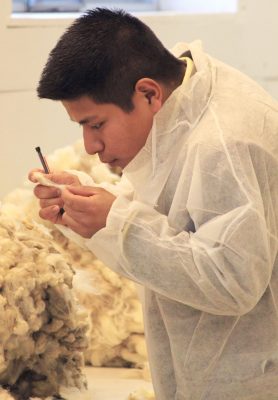
Finding a wool judging team at the University of Wyoming only makes sense with the state being one of the top five wool producers in the nation.
But 18 years have passed since there has been any record of a wool judging team.
Led by Whit Stewart, an assistant professor in the Department of Animal Science and UW Extension sheep specialist, the newly created wool judging team is preparing to compete at the National Western Stock Show (NWSS) in Denver Jan. 17.
Stewart coached two wool judging teams as part of his assistantship while working on his doctorate at New Mexico State University. This is primarily where he gained his collegiate coaching experience, he noted. Stewart also co-coached a 4-H wool judging team in Gillette while working for UW Extension in Campbell County.
He said creating the team complements efforts to keep the sheep program.
“When we look toward attracting students in the college of ag, those sheep-specific students who have a real interest in sheep production, this is a great competition for them because it’s based on real industry standards,” said Stewart. “It’s something that complements their education, their oral articulation skills, their ability to reason through a challenge and use logic.”
The 13-member UW team has two assistant coaches, Katie Hazlewood and Bryce McKenzie.
Different types of wool have different uses. Competitors must identify and attribute a value to different types of wool as part of the judging.
There are three components to the contest.
Grading reel
Students examine 15 different fleeces (one fleece is the wool off one sheep for a year’s worth of growth) in the grading reel. They identify the micron of the wool, which tells how fine the wool is and its uses, such as “next-to-skin,” outwear, carpets or blankets.
Then they identify the clean yield on the fleece, which is a percentage range. There are also length requirements as well as character and purity designations. All of these factors relate to the industry and the value of the fleece. This first part of the contest is worth the majority of the points.
Commercial and breed classes
Commercial and breed classes are the next contest components. There are four fleeces per class. Students rank the fleeces based on clean wool production for the commercial side. The breed classes could have four or five different sheep breeds and are placed based on clean weight and breed characteristics of the wool.
“This requires students to know aspects about the commercial wool industry and then what attributes make good purebred fleeces,” Stewart said.
Oral reasons
Oral reasons is the final component. Students have to give three oral reasons based on the wool they judged earlier; however, they do not know at the time which classes, breed or commercial, so they have to be accurate on the breed character and the commercial side.
Juan Gavette, a senior from Everson, Wash., said, he joined the team because he loves competing in the contests but also said the wool industry is an important sector of the agricultural industry and by joining the wool judging team, he has furthered his knowledge in this area.
Dallin Brady, a senior from Kimberly, Idaho, mentioned that through wool judging, he has networked with and learned from a variety of producers and industry leaders.
The team practices about six to eight hours a week using fleeces provided by the Wyoming Wool Growers Association and the Wyoming State Fair.
The main goal for the team this year is to do well at NWSS. Members said they would like to place among the top five to justify attending the next national contest at Houston Livestock Show and Rodeo in March.
Eventually, as the program becomes more established and competitive, Stewart hopes to have the team compete at the San Antonio Stock Show and Rodeo in February as well.
“We want to build a program here at UW for kids all over the country who are interested in the sheep and wool production, and this is a good next step to making that come to fruition,” Stewart said.
He said students should contact him if interested in joining the team next year. They are required to take a one credit course during the fall semester before competing during the spring semester.
“It’s good for students who have a judging interest, but it’s also good for students who have an interest in the wool industry,” Stewart said.




